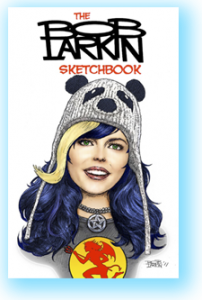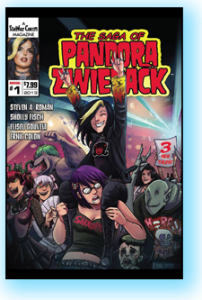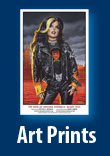I’ve been friends with author/artist/ playwright/musician Scott Zwiren going all the way back to our student days at New York University, when he and I and Sholly Fisch (these days the acclaimed writer of DC’s Scooby-Doo Team-Up, and contributor to SWC’s Saga of Pandora Zwieback Annual #1) were members of NYU’s humor magazine, The Plague—which apparently is still running!
Scott has had some literary acclaim of his own, as the author of the novel Godhead, which examines manic depression from a first-person prespective. Most recently, he’s taken the plunge into self-publishing (hey, join the club!), with three releases: Telling Stories, Painting Pictures, and Seeing Things, all available from Amazon. If you’re intrigued by the notion of “picto-fiction” (to use an old term) tales told mostly in images, in a style that’s reminiscent of the works of Gahan Wilson, Ralph Steadman, and Charles Addams, then do yourself a favor and check them out.
But before you do, Scott asked if he could post a couple of reviews about two SWC titles he enjoyed: The Bob Larkin Sketchbook, a pencil-art collection by the legendary cover painter for Marvel Comics and numerous other publishers; and The Saga of Pandora Zwieback Annual #1, which contains tales of the teenaged monster hunter. Who am I to say no? 😀
Take it away, Scott!
 THE BOB LARKIN SKETCHBOOK
THE BOB LARKIN SKETCHBOOK
We know that Bob Larkin is a master of line, tone and color and anyone who has ever seen his color work on Doc Savage, Conan the Barbarian, or The Incredible Hulk knows that he is bolder than any artist trying to master the anatomy of a superhero who has musculature that is greater than any bodybuilder anatomy that makes a vein the size of electric cable seem totally natural That is Larkin’s skill—to not be hyper-real but realistic, and convince you that his subject is completely real.
The cover of the sketchbook shows how Larkin can treat a more sensitive subject. In his hands Pandora Zwieback is magical from the luster of her indigo hair to her vivid green eyes. The art of a non-color graphite drawing shows Larkin’s treatment of light and shadow, the signature mark and cross-hatching. My favorites are the beautifully lit Doctor Strange; the lines on “Stone Cold” Steve Austin that make up his face; and the dueling Shadow and Doc Savage centerfold.
The title that this is simply a sketchbook is a misnomer. It is a collection of finished art.
 THE SAGA OF PANDORA ZWIEBACK ANNUAL #1
THE SAGA OF PANDORA ZWIEBACK ANNUAL #1
The cover of the Pandora Zwieback Annual is pretty much a monster Mardi Gras parade that is followed by a splash page of great depth of three-point perspective that is colored with unusual beauty and depicts the night as eerie as Pandora is alluring.
In the opening story, “Song of the Siren,” by Steve Roman and artist Eliseu Gouveia, the story line has an attention to detail that includes a lyric from a 1970s Chicago song (“Saturday in the Park”), a Mets bobblehead doll, and a lyric from a Cheap Trick hit (“Surrender”), then refers to the Bronx Bombers and a curse in Spanish equivalent to the evil eye. What this attention to detail does is introduce us into the life of Pandora—a charming teenage Goth who just happens to see the monsters that no one else can. Well, almost. Enter her mentor, Sebastienne…
What seems to start as a normal teenage first date is interrupted by the danger of a trio of very leggy mean girls. The leader is Sophia, Pan’s boyfriend’s ex, who turns out to be a Siren—not of the hypnotizingly beautiful type, but of the Greek mythological type. Monsters are always this interesting but seldom this polite before the fight. Best line here belongs to Pandora’s adversary: “How romantic. The boy infatuated with monsters—and the freak who can see monsters. I’m sure you make a lovely couple.” It seldom gets more deliciously evil.
The middle tale, “After Hours,” by Sholly Fisch and artist Ernie Colon, is an allegorical joke where a demon that is devil-may-care and full of family values comes to a bar as a regular and is followed by his antithesis, who has a cross to bear.
The final story, “Shopping Maul,” is the topper. If the measure of good genre fiction is what makes it believable, Steve Roman moves between the mind of a vampire, a contemporary teen, and the topography of Sunnyside, Queens so well and so seemingly effortlessly. The prose is so good that you are there. As an aging Met fan would say, “Ya gotta believe!” It is just that good.






